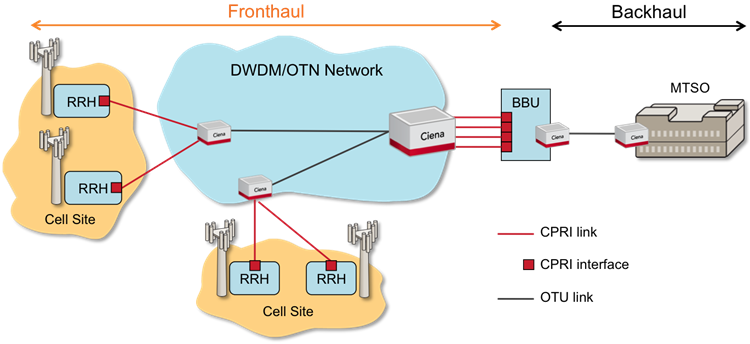Primer: What is mobile fronthaul?
According to the latest stats from the CTIA, over 4.1 trillion megabits of mobile data was consumed in 2014 – and that’s just in the U.S. alone. All that mobile traffic eventually has to be transported back over traditional wired (and mainly fiber optic) networks. That’s where mobile backhaul comes into play.
But there’s a new mobile architecture to talk about as well: mobile fronthaul.
In this primer we’ll explain mobile backhaul vs mobile fronthaul and how they address the growing challenge of helping transport today’s massive mobile traffic loads.
Mobile Backhaul
In its simplest form, backhaul connects the mobile network to the wired network by backhauling traffic from geographically dispersed cell sites to Mobile Switching Telephone Offices (MTSOs). These links, which interconnect macro cell sites (e.g., sites housing those large towers you can easily see at great distances) to MTSOs, are quickly migrating from slower TDM-based T1/E1 connections towards packet-based Ethernet-over-Fiber links, typically via 1Gbps physical interfaces to the macro cell site.
Within a typical macro cell site resides a Baseband Unit (BBU) connected to a Radio Unit (RU). The former processes user and control data, while the latter generates radio signals transmitted over the airwaves via tower-mounted antennas.
Mobile Fronthaul
Fronthaul is associated with a new and different type of Radio Access Network (RAN) architecture consisting of centralized baseband controllers and standalone radio heads installed at remote cell sites located kilometers to tens of kilometers away. These BBU and RU functional blocks, as well as the equipment that performs these functions, are located further away from each other than in the mobile backhaul model.
In the fronthaul model, the RU equipment is now referred to as a Remote Radio Head (RRH) but is still located at the cell site. The BBU is now relocated to centralized and protected location where it serves multiple RRHs. The optical links that interconnect the newly centralized BBU and the multiple RRHs is referred to as fronthaul.

A cooperative consortium of wireless equipment vendors standardized the Common Public Radio Interface (CPRI) protocol that runs over these fronthaul links back in June of 2003. CPRI can be carried over tens of kilometers, is compatible with low-cost and ubiquitous SFP/SFP+ pluggables, and leverages cost-effective modulation schemes, such as Quadrature Amplitude Modulation (QAM). Compatible with a multitude of optical transceivers from other common physical layers standards, such as those listed below, CPRI also helps keep network costs down while facilitating optical link engineering.
- 1000Base-SX/LX Ethernet (IEEE 802.3-2002, clause 38)
- 10GBase-LX4 Ethernet (IEEE 802.3-2005, clause 53)
- Fiber Channel (FC-PI-4, INCITS revision 8)
- Infiniband (volume 2, release 1.1, November 2002)
- 10GBase-S/L/E 10G Ethernet (IEEE 802.3-2008, clause 52)
The high performance requirements of CPRI -- as they relate to capacity, reach, and especially latency -- mandate fiber connectivity between centralized BBUs and the multiple RRHs. Using grey, CWDM, and/or DWDM optics satisfies these needs, depending upon application specifics such as availability of fiber to the cell site and on the tower feeding the RRHs mounted at the top of its mast. Supported CPRI rates of 2.458Gbps, 3.072Gbps, 4.915Gbps, 6.144Gbps, 9.830Gbps, and potentially beyond, are relatively high when compared to the much lower 1Gbps macro backhaul links commonly deployed today. This higher CPRI bandwidth directly correlates to complex and uncompressed baseband data samples.
There’s quite a big difference between backhaul and fronthaul in today’s mobile networks, especially among the protocols, capacities, latencies, reaches, and associated applications. However, both backhaul and fronthaul will continue to have a place within the ever-changing mobile networks of tomorrow.





